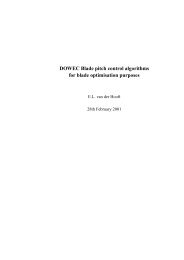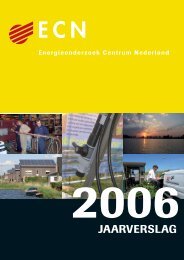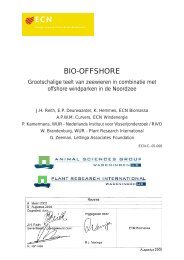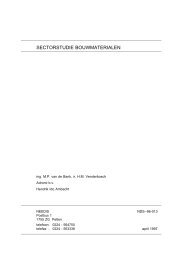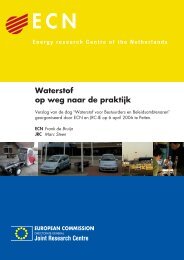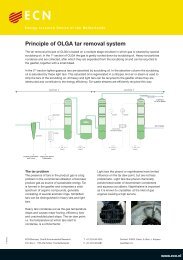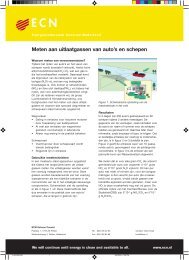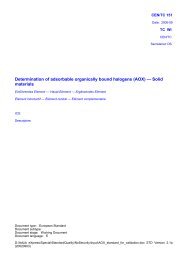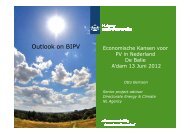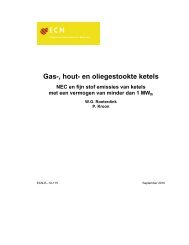PDF format (503 kB) - ECN
PDF format (503 kB) - ECN
PDF format (503 kB) - ECN
You also want an ePaper? Increase the reach of your titles
YUMPU automatically turns print PDFs into web optimized ePapers that Google loves.
GER values<br />
Direct energy use<br />
(MJ/vkm)<br />
Indirect energy use<br />
(MJ/vkm)<br />
Occupancy rate<br />
Direct energy ue<br />
(MJ/pkm)<br />
Indirect energy use<br />
(MJ/pkm)<br />
ERE value (MJ/MJ)<br />
Total primary energy<br />
use (MJ/pkm)<br />
Methodology<br />
The reduction potential of passenger transport is calculated in relative terms, resulting in a reduction percentage<br />
per unit of transport. The unit to compare the situations in 1990 and 2050 is the transportation of one person<br />
over a kilometre distance (pkm). This unit comes closest to the demand for transports, which is usually not<br />
a demand for vehicle kilometres (vkm), but a demand to cover a certain distance. The magnitude of the demand<br />
is largely influenced by the spatial settings and the activity patterns of each individual.<br />
For a reduction potential analysis, the motorised transport demand is of importance. We discern individual and<br />
public transportation systems. In Europe, fourteen per cent of the transport demand is covered with public<br />
transport, 86 % with individual passenger cars (Schol and Ybema, 1998). We do not include soft modes like<br />
walking and cycling in our analysis, as their energy use and emissions are minimised already. In<strong>format</strong>ion<br />
about the overall share of soft modes in Europe is not available. Of the total mobility demand in the Netherlands<br />
in 1994, about 10 per cent is covered with soft modes (CBS, 1995). This share is likely to be relatively<br />
large compared to the European average, as the share of cycling is relatively large in the Netherlands.<br />
The reference energy use in 1990 is the energy use per passenger kilometre in a passenger car. This energy use<br />
is calculated, based on both the direct and indirect energy use of the vehicle, and the occupancy rate.<br />
Figure 1 gives an overview of the calculation of the reference energy use. The direct energy use per vehicle<br />
kilometre comprises fuel used for transportation and depends on engine technology, car size, etc. The indirect<br />
energy use comprises the energy use associated with production and maintenance of the vehicle. The value of<br />
the indirect energy use is influenced by the vehicle production energy use, the energy needed to produce car<br />
materials (Gross energy requirement of GER value of the materials), the annual use of the vehicle and the total<br />
lifetime. In order to convert the direct and indirect energy use per vehicle kilometre to the value per passenger<br />
kilometre, the values are divided by the average occupancy rate of the vehicle. The next step in figure 1 is the<br />
conversion of the direct energy use to the primary energy use. For doing so, the direct energy use is multiplied<br />
by the energy demand for fuel winning (ERE value, or Energy Required for Energy). The goals set in the introduction<br />
on the reduction potential needed for transportation are based on<br />
overall reductions. The total primary energy use per passenger kilometre implies the energy requirements of all<br />
processes associated with the use of a passenger car.<br />
Calculating this value for the average OECD Europe passenger car and occupancy rate provides an energy use<br />
of 0.4 MJ indirect and 1.9 MJ direct per passenger kilometre. The summed total of these two values gives a total<br />
primary energy use of 2.3 MJ per passenger kilometre in 1990. This paper assesses the possibility of reducing<br />
this value with 50% by 2020 to 1.2 MJ per pkm, and with 90% by 2050 to 0.2 MJ per pkm.<br />
Figure 1 Calculating the total primary energy use per passenger kilometer<br />
CO2 emission is directly related to energy consumption. To attribute to sustainability, reducing CO2 emission is<br />
an important goal. The exact amount of CO2 emission can be calculated based on the total energy consumption.<br />
However, the amount of CO2 emission per unit energy use also depends on some external factors, like the pro-



